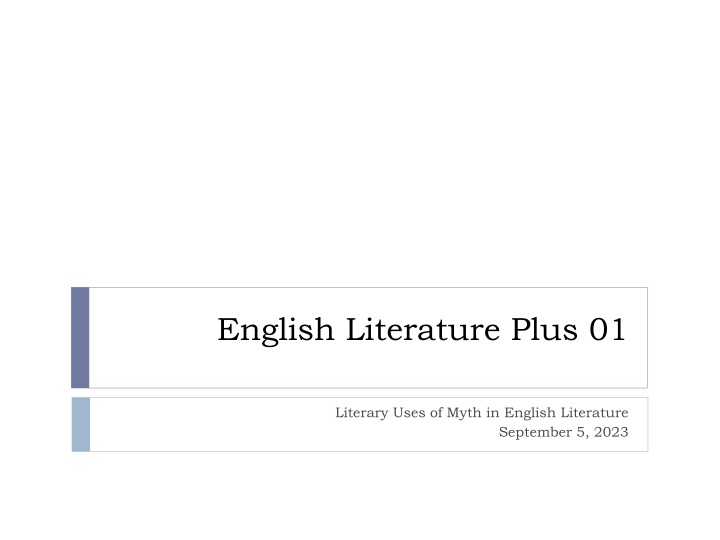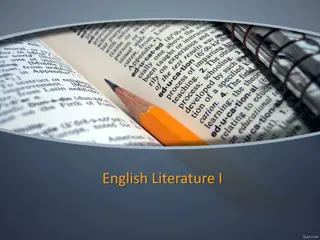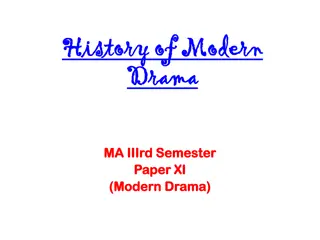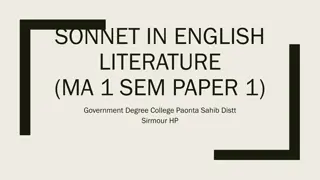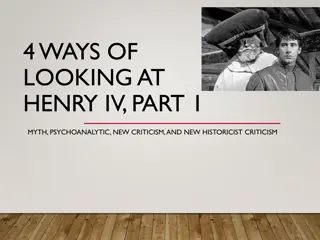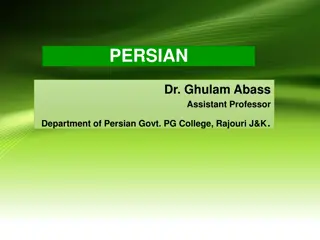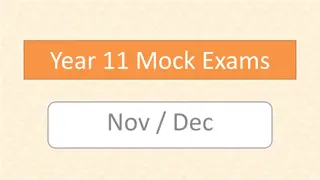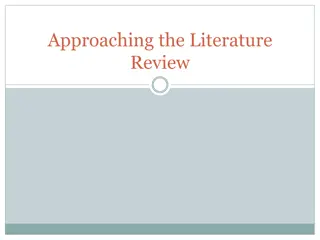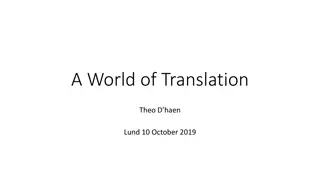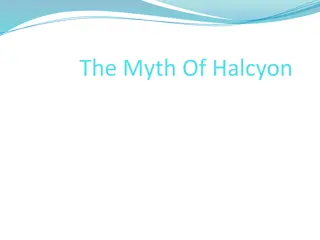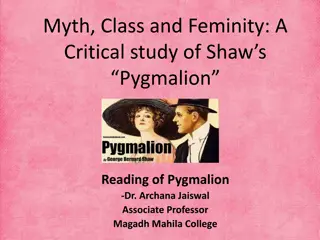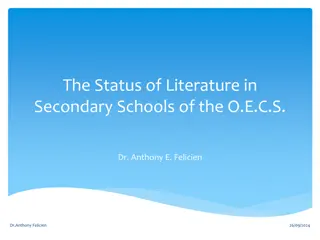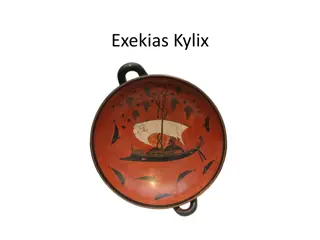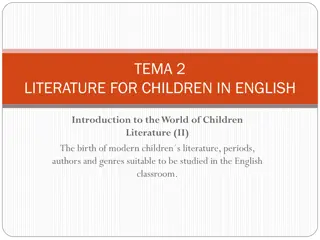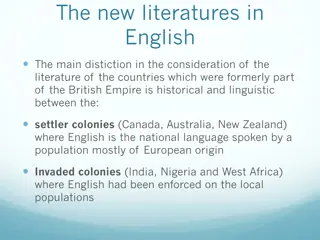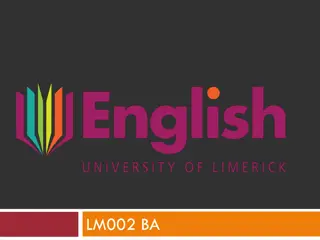Evolution of Myth in English Literature
The evolution of myth in English literature, from the medieval period to the Romantic era, reflects a shift in how classical myths were interpreted and utilized. Medieval scholars allegorized myths to align them with Christian beliefs, while Renaissance writers integrated classical myths with Christian doctrine. The 17th and 18th centuries saw a decline in myth's prominence, only to be revived as a cultural phenomenon. The Romantic poets embraced myth as a vehicle for insight, highlighting its timeless relevance and metaphorical power in nature.
Download Presentation

Please find below an Image/Link to download the presentation.
The content on the website is provided AS IS for your information and personal use only. It may not be sold, licensed, or shared on other websites without obtaining consent from the author.If you encounter any issues during the download, it is possible that the publisher has removed the file from their server.
You are allowed to download the files provided on this website for personal or commercial use, subject to the condition that they are used lawfully. All files are the property of their respective owners.
The content on the website is provided AS IS for your information and personal use only. It may not be sold, licensed, or shared on other websites without obtaining consent from the author.
E N D
Presentation Transcript
English Literature Plus 01 Literary Uses of Myth in English Literature September 5, 2023
Classical(Latin) Literature in the Medieval Period To preserve Latin literature inevitably meant preserving classical mythology. This posed a serious problem for the Church and Christian readers because the myths were an integral part of a false, pagan belief system. The most popular medieval solution to this dilemma was to treat the myths allegorically. The examples are the voyages of Odysseus or Aeneas as the human journey through life, Cronus eating his children could be rationalised as a symbol of devouring Time. 1. 2. 3. 4. 2 2023 English Literature Plus Slide 02
The Renaissance as a period of rediscovery of the classics The lead was taken by the humanist scholars who were interested in human rather than theological studies. They believed in the ideal of 'humane' learning which creates a well-rounded human being. They searched out manuscripts of Latin texts as well as Greek texts long unknown in the west. A new kind of respect for classical literature as a model for imitation and a new ideal of education whose curriculum was centred on Latin and Greek. 1. 2. 3. 4. 3 2023 English Literature Plus Slide 02
Myth as allegory/romance in the Renaissance Period Major writers like Edmund Spenser(The Fairie Queene) and John Milton(Paradise Lost) draw upon the tradition of allegorical interpretation, interweaving classical myths with Christian doctrine. Erotic Epyllions[mini-epic] such as Shakespeare s Venus and Adonis and Marlowe s Hero and Leander create an idealised mythic world, without allegory or Christianising. 1. 2. 4 2023 English Literature Plus Slide 02
Myth in the 17th and 18th century 1. The lowest decline of myth in English literature. 2. But its revival at the end of the eighteenth century was led by the scholars who studied the classical myths simply as cultural phenomena rather than as sources of ancient wisdom or of pagan corruption. 5 2023 English Literature Plus Slide 02
Myth in the Romantic Period With their exaltation of imagination over mere reason, their worship of nature, their love of fantasy and romance, they were prepared to see the myth not as a childish and outmoded habit of thought but as a perennially valid vehicle of insight: for them, to see the landscape as inhabited by the presences of gods, nymphs, and satyrs was not a primitive superstition or a conventional image but a vivid metaphor for the divine power which pervades the natural world. 1. 6 2023 English Literature Plus Slide 02
Shelleys comments in the preface to his play Hellas(1822) We are all Greeks. Our laws, our literature, our religion, our arts have their roots in Greece ... The human form and the human mind attained to a perfection in Greece which has impressed its image on those faultless productions, whose very fragments are the despair of modern art, and has propagated impulses which cannot cease . . . to ennoble and delight mankind until the extinction of the race. 7 2023 English Literature Plus Slide 02
Myth in the nineteenth century In the Victorian period, mythology comes to seem increasingly marginal. In the latter half of the century, Pre-Raphaelites like D. G. Rossetti and William Morris use it to create an idealised dream-world, a vanished time which can be contemplated with wistful nostalgia. 1. 2. 8 2023 English Literature Plus Slide 02
Myth and Modernism of the early twentieth century Sir James Frazer in his massive study The Golden Bough applied the techniques of modern anthropology to ancient myth and religion, finding startling similarities between classical myths and the beliefs of present-day primitive peoples. Psychoanalysis and Myth: For Sigmund Freud, they embody primal human drives of sexuality and violence, which may emerge in dreams or fantasies when the rational mind represses them. For Carl Jung, they are archetypes , powerful images from the collective unconscious of the entire human race, embodying our deepest desires and needs. Once again, as in the Renaissance, myths are seen as symbolic representations of profound truth. Their irrationality is no longer a barrier to taking them seriously - in fact, in an irrational and chaotic modern world, it guarantees their significance and value(p.14). 1. 2. 3. 4. 9 2023 English Literature Plus Slide 02
T. S. Eliot review of James Joyces Ulysses (1922) Psychology ... , ethnology and The Golden Bough have concurred to make possible what was impossible only a few years ago. Instead of narrative method, we may now use the mythical method. It is, I seriously believe, a step toward making the modern world possible for art. The modernist writers of the earlier twentieth century embraced myth as a way of imposing significance on a chaotic or shabby modern world. Eliot s The Waste Land (1922) draws on Frazer s discussion of ancient fertility myths, creating a waste land which images both the chaos of post-war Europe and the arid psyche of contemporary western man(p. 15). 1. 2. 3. 10 2023 English Literature Plus Slide 02
Myth in the later twentieth century The decline of the classical education' and of knowledge of the classical languages, the rising protests against literary elitism and the dominance of Dead White European Males. A new approaches to Myth: Multiculturalism and Feminism. 1. 2. 11 2023 English Literature Plus Slide 02
Myth in the twenty-first century If knowledge of Greek and Latin has declined, translations of classical works and popular accounts of the myths proliferate. Ovid, in particular, seems to be undergoing a boom in the 1990s. In the age of postmodernism and magical realism, Ovid, with his mixture of wit and fantasy and violence, his artful fragmentariness and his hints of serious meaning under a kaleidoscopically frivolous surface, once again seems a very modern writer. 1. 2. 3. 12 2023 English Literature Plus Slide 02
